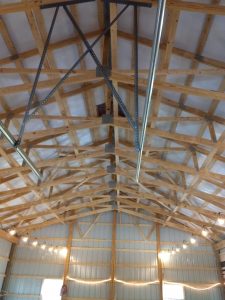Roof Trusses are structural frameworks, generally two-dimensional, whose members are almost always assembled to form a series of inter-connected triangles, Perimeter members of the assembly are called truss chords and interior members are called truss webs.
Metal plate connected wood trusses (MPCWT) are composed of wood members joined with metal connector plates (also known as truss plates). These metal connector pates are light-gauge, toothed steel plates.
MPCWT are an integral part of most pole buildings. Their use allows for wide cost-effective clearspans and greatly speeds jobsite construction.
Hansen Pole Buildings, like most providers of pole building kit packages, does not fabricate our own trusses. Outsourcing allows us to provide economical solutions which are relatively local to each building site, by holding delivery costs to reasonable levels.
One of our clients recently had some concerns regarding the quality of the trusses received at his site. Each of our clients is provided with a secure individual log-in to their portion of our website, which allows them to quickly and easily upload photos. Using this system, the client provided some interesting photos. Among them were some where the client could fully place his finger between some of the wooden members of the trusses.
 In a not too distant past life, I owned two truss plants for 17 years. In sum total, I owned, managed or worked in one capacity of another in truss manufacturing companies for over two decades. Truss manufacturers are not only responsible for in plant quality control, they are also subjected to random third-party inspections quarterly. The process is rigorous – no manufacturer ever wants to fail an inspection.
In a not too distant past life, I owned two truss plants for 17 years. In sum total, I owned, managed or worked in one capacity of another in truss manufacturing companies for over two decades. Truss manufacturers are not only responsible for in plant quality control, they are also subjected to random third-party inspections quarterly. The process is rigorous – no manufacturer ever wants to fail an inspection.
The Truss Plate Institute has a lengthy document governing the entire truss process – including quality control. For those of you who like to read, or have issues falling asleep at night, the ANSI/TPI 1-2007 standard can be read online for free at: https://design.medeek.com/resources/truss/documents/ANSI_TPI1-2007_Standard_and_Commentary-Appendices.pdf
The relevant portions of the document regarding Wood Member-To-Wood Member Gaps is found at 3.7.6.1 of the document:
“Except as indicated in Section 3.7.6.2 or as otherwise specified on the Truss Design Drawing, maximum gaps in all joints except floor Truss chord splices shall not exceed 1/8 in. (3 mm), where the gap is measured at each edge of the Metal Connector Plate for joints in which the plate edge is within the scarf, and measured at the end of the scarf for joints in which the plate edge is outside the scarf. Scarf is the portion of the joint in which it is intended that there be wood-to-wood contact between two Wood Members. The maximum gap for floor Truss chord splices shall not exceed 1/16 in (1.5 mm) across the entire scarf. For joints designed with single points of contact between adjacent members as shown on the Truss Design Drawing, the maximum gap between all contact points shall not exceed 1/8 in. (3 mm).”
Pretty tough requirements!
In the case of these particular trusses in question, the photographs were forwarded to the manufacturer, and their engineer provided sealed documentation of their adequacy. The manufacturer also had a representative make a personal visit to the client to examine the trusses and verify they met with the engineer’s expectations.






